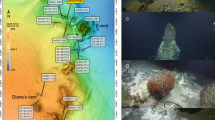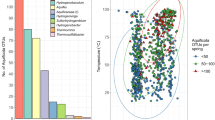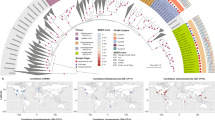Abstract
Hydrothermal vent systems host microbial communities among which several microorganisms have been considered endemic to this type of habitat. It is still unclear how these organisms colonize geographically distant hydrothermal environments. Based on 16S rRNA gene sequences, we compare the bacterial communities of sixteen Atlantic hydrothermal vent samples with our own and publicly available global open ocean samples. Analysing sequences obtained from 63 million 16S rRNA genes, the genera we could identify in the open ocean waters contained 99.9% of the vent reads. This suggests that previously observed vent exclusiveness is, in most cases, probably an artefact of lower sequencing depth. These findings are a further step towards elucidating the role of the open ocean as a seed bank. They can explain the predicament of how species expected to be endemic to vent systems are able to colonize geographically distant hydrothermal habitats and contribute to our understanding of whether ‘everything is really everywhere’.
This is a preview of subscription content, access via your institution
Access options
Subscribe to this journal
Receive 12 digital issues and online access to articles
$119.00 per year
only $9.92 per issue
Buy this article
- Purchase on Springer Link
- Instant access to full article PDF
Prices may be subject to local taxes which are calculated during checkout


Similar content being viewed by others
References
Gibbons, S. M. et al. Evidence for a persistent microbial seed bank throughout the global ocean. Proc. Natl Acad. Sci. USA 110, 4651–4655 (2013).
Campbell, B. J., Engel, A. S., Porter, M. L. & Takai, K. The versatile ε-proteobacteria: key players in sulphidic habitats. Nature Rev. Microbiol. 4, 458–468 (2006).
Sievert, S. M. & Vetriani, C. Chemoautotrophy at deep-sea vents: past, present, and future. Oceanogr. Mar. Biol. 25, 218–233 (2012).
Perner, M. et al. In-situ chemistry and microbial community compositions in five deep-sea hydrothermal fluid samples from Irina II in the Logatchev field. Environ. Microbiol. 15, 1551–1560 (2013).
Huber, J. A. et al. Isolated communities of ε-proteobacteria in hydrothermal vent fluids of the Mariana Arc seamounts. FEMS Microbiol. Ecol. 73, 538–549 (2010).
Beaulieu, S. E., Baker, E. T. & German, C. R. Where are the undiscovered hydrothermal vents on oceanic spreading ridges?. Deep-Sea Res. II 121, 202–212 (2015).
Stein, J. & Fisher, A. Observations and models of lateral hydrothermal circulation on a young ridge flank: numerical evaluation of thermal and chemical constraints. G3 4, 1026 (2003).
Clarke, K. R. Non-parametric multivariate analyses of changes in community structure. Aust. J. Ecol. 18, 117–143 (1993).
Sogin, M. L. et al. Microbial diversity in the deep sea and the underexplored ‘rare biosphere’. Proc. Natl Acad. Sci. USA 103, 12115–12120 (2006).
Galand, P. E., Casamayor, E. O., Kirchman, D. L. & Lovejoy, C. Ecology of the rare microbial biosphere of the Arctic Ocean. Proc. Natl Acad. Sci. USA 106, 22427–22432 (2009).
Caporaso, J. G., Paszkiewicz, K., Field, D., Knight, R. & Gilbert, J. A. The western English Channel contains a persistent microbial seed bank. ISME J. 6, 1089–1093 (2012).
Anderson, R., Sogin, M. L. & Baross, J. A. Biogeography and ecology of the rare and abundant microbial lineages in deep-sea hydrothermal vent. FEMS Microbiol. Ecol. 91, 1–11 (2015).
Huber, J. A. et al. Microbial population structures in the deep marine biosphere. Science 318, 97–100 (2007).
Pedrós-Alió, C. Marine microbial diversity: can it be determined? Trends Microbiol. 14, 257–263 (2006).
Friedline, C., Franklin, R., McCallister, S. & Rivera, M. Bacterial assemblages of the eastern Atlantic Ocean reveal both vertical and latitudinal biogeographic signatures. Biogeosciences 9, 2177–2193 (2012).
Sunagawa, S. et al. Ocean plankton. Structure and function of the global ocean microbiome. Science 348, 1261359 (2015).
Rideout, J. R. et al. Subsampled open-reference clustering creates consistent, comprehensive OTU definitions and scales to billions of sequences. PeerJ 2, e545 (2014).
Baas Becking, L. Geobiologie of Inleiding Tot de Milieukunde. in Geobiology or Introduction to the Science of the Environment (Van Stockum & Zoon, 1934).
Liu, Z., Lozupone, C., Hamady, M., Bushman, F. D. & Knight, R. Short pyrosequencing reads suffice for accurate microbial community analysis. Nucleic Acids Res. 35, e120 (2007).
Dworkin, M. & Falkow, S. The Prokaryotes: A Handbook on the Biology of Bacteria 3rd edn (Springer, 2006).
Zielinski, F. U. et al. Widespread occurrence of an intranuclear bacterial parasite in vent and seep bathymodiolin mussels. Environ. Microbiol. 11, 1150–1167 (2009).
Wentrup, C., Wendeberg, A., Schimak, M., Borowski, C. & Dubilier, N. Forever competent: deep-sea bivalves are colonized by their chemosynthetic symbionts throughout their lifetime. Environ. Microbiol. 16, 3699–3713 (2014).
Rocap, G. et al. Genome divergence in two Prochlorococcus ecotypes reflects oceanic niche differentiation. Nature 424, 1042–1047 (2003).
Perner, M. et al. Linking geology, fluid chemistry and microbial activity of basalt- and ultramafic-hosted deep-sea hydrothermal vent environments. Geobiology 11, 340–355 (2013).
Garbe-Schönberg, D., Jähmlich, H., Koschinsky, A., Ratmeyer, V. & Westernströer, U. KIPS—a new multiport valve-based all-Teflon fluid sampling system for ROVs. EGU Meeting, Geophys. Res. Abstr. 8, 07032 (2006).
Perner, M. et al. Short-term microbial and physico-chemical variability in low-temperature hydrothermal fluids near 5°S on the Mid-Atlantic Ridge. Environ. Microbiol. 11, 2526–2541 (2009).
Klindworth, A. et al. Evaluation of general 16S ribosomal RNA gene PCR primers for classical and next-generation sequencing-based diversity studies. Nucleic Acids Res. 41, e1 (2013).
Bolger, A. M., Lohse, M. & Usadel, B. Trimmomatic: a flexible trimmer for Illumina sequence data. Bioinformatics 30, 2114–2120 (2014).
Langmead, B. & Salzberg, S. L. Fast gapped-read alignment with Bowtie 2. Nature Methods 9, 357–359 (2012).
Magoc, T. & Salzberg, S. L. FLASH: fast length adjustment of short reads to improve genome assemblies. Bioinformatics 27, 2957–2963 (2011).
Caporaso, J. G., Kuczynski, J. & Stombaugh, J. QIIME allows analysis of high-throughput community sequencing data. Nature 7, 335–336 (2010).
Quast, C. et al. The SILVA ribosomal RNA gene database project: improved data processing and web-based tools. Nucleic Acids Res. 41, D590–D596 (2013).
Edgar, R. Search and clustering orders of magnitude faster than BLAST. Bioinformatics 26, 2460–2461 (2010).
Caporaso, J. G. et al. PyNAST: a flexible tool for aligning sequences to a template alignment. Bioinformatics 26, 266–267 (2010).
Price, M. N., Dehal, P. S. & Arkin, A. P. FastTree 2—approximately maximum-likelihood trees for large alignments. PLoS ONE 5, e9490 (2010).
Chao, A. et al. Rarefaction and extrapolation with Hill numbers: a framework for sampling and estimation in species diversity studies. Ecol. Monogr. 84, 45–67 (2014).
Lozupone, C., Lladser, M. E., Knights, D., Stombaugh, J. & Knight, R. UniFrac: an effective distance metric for microbial community comparison. ISME J. 5, 169–172 (2011).
Leinonen, R., Sugawara, H. & Shumway, M. The sequence read archive. Nucleic Acids Res. 39, D19–D21 (2011).
Huse, S. M. et al. VAMPS: a website for visualization and analysis of microbial population structures. BMC Bioinformatics 15, 41 (2014).
Egbert, G. & Erofeeva, S. Efficient inverse modeling of barotropic ocean tides. J. Atmos. Ocean. Technol. 19, 183–204 (2002).
Walter, M. et al. Rapid dispersal of a hydrothermal plume by turbulent mixing. Deep-Sea Res I 57, 931–945 (2010).
Carpenter, J. H. The Chesapeake Bay Institute technique for the Winkler dissolved oxygen method. Limnol. Oceanogr. 10, 141–143 (1965).
Cline, J. Spectrophotometric determination of hydrogen sulfide in natural waters. Limnol. Oceanogr. 14, 454–458 (1969).
Perner, M. et al. The influence of ultramafic rocks on microbial communities at the Logatchev hydrothermal field, located 15°N on the Mid-Atlantic Ridge. FEMS Microbiol. Ecol. 61, 97–109 (2007).
Seifert, R. et al. Ethylene and methane in the upper water column of the subtropical Atlantic. Biogeochemistry 44, 73–91 (1999).
Schmidt, K. A. et al. Fluid elemental and stable isotope composition of the Nibelungen hydrothermal field (8°18′S, Mid-Atlantic Ridge): constraints on fluid–rock interaction in heterogeneous lithosphere. Chem. Geol. 280, 1–18 (2011).
Schmidt, K., Koschinsky, A., Garbe-Schönberg, D., de Carvalho, L. M. & Seifert, R. Geochemistry of hydrothermal fluids from the ultramafic-hosted Logatchev hydrothermal field, 15°N on the Mid-Atlantic Ridge: temporal and spatial investigation. Chem. Geol. 242, 1–21 (2007).
Benjamini, Y. & Hochberg, Y. Controlling the false discovery rate: a practical and powerful approach to multiple testing. J. R. Stat. Soc. Ser. B 57, 289–300 (1995).
Acknowledgements
The authors thank the captain and crews of the research vessels and ROV Kiel6000 (GEOMAR, Kiel) for helping us to obtain deep-sea vent samples. The authors also thank H. Strauss for providing data on hydrogen sulfide and M. Alawi for discussions regarding the sequencing and bioinformatics analysis. The work was supported by grants from priority programme 1144 ‘From Mantle to Ocean: Energy-, Material- and Life-cycles at Spreading Axes’ of the German Science Foundation (DFG). S.B. was funded by grant no. DFG PE 1549-6/1.
Author information
Authors and Affiliations
Contributions
M.P. designed the research project, planned the sequencing and wrote the paper. G.G. co-planned the sequencing, performed bioinformatics and statistical analyses and wrote the paper. S.B. performed experiments. D.I. performed sequencing. D.G.-S. contributed fluid elemental compositions and geochemical data. R.S. measured hydrogen and methane concentrations. C.M. performed tidal measurements. S.K. advised on the bioinformatics analyses and wrote the paper.
Corresponding author
Ethics declarations
Competing interests
The authors declare no competing financial interests.
Supplementary information
Supplementary information
Supplementary Results and Discussion 1-4, Supplementary Figures 1-6, Supplementary Tables 1-4, Supplementary Table legends 5-10, and Supplementary References (PDF 896 kb)
Supplementary Table 5
Genera shared between hydrothermal vent and open ocean samples. (XLSX 190 kb)
Supplementary Table 6
Open-reference based OTUs shared between hydrothermal vent and open ocean samples. (XLSX 1109 kb)
Supplementary Table 7
Environmental parameters of the different samples used for correlation analyses. (XLSX 14 kb)
Supplementary Table 8
Spearman correlations for the different sites between environmental parameters and bacterial classes. (XLSX 31 kb)
Supplementary Table 9
Spearman correlations for the different sites between environmental parameters and bacterial genera. (XLSX 78 kb)
Supplementary Table 10
Spearman correlations for the different sites between environmental parameters and bacterial OTUs. (XLSX 2668 kb)
Rights and permissions
About this article
Cite this article
Gonnella, G., Böhnke, S., Indenbirken, D. et al. Endemic hydrothermal vent species identified in the open ocean seed bank. Nat Microbiol 1, 16086 (2016). https://doi.org/10.1038/nmicrobiol.2016.86
Received:
Accepted:
Published:
DOI: https://doi.org/10.1038/nmicrobiol.2016.86
This article is cited by
-
Application of culturomics in fungal isolation from mangrove sediments
Microbiome (2023)
-
Sulfur cycling connects microbiomes and biogeochemistry in deep-sea hydrothermal plumes
The ISME Journal (2023)
-
Genome-centric insight into metabolically active microbial population in shallow-sea hydrothermal vents
Microbiome (2022)
-
Genome-resolved evidence for functionally redundant communities and novel nitrogen fixers in the deyin-1 hydrothermal field, Mid-Atlantic Ridge
Microbiome (2022)
-
The rates of global bacterial and archaeal dispersal
The ISME Journal (2022)



